How to Build a Chatbot for Help Desk Support in 2025

To build a chatbot for help desk support in 2025, you need to use advanced ai chatbot technology that delivers instant answers and works around the clock. Businesses now save up to 30% in support costs and resolve 80% of routine questions with ai chatbot solutions. The Sobot AI chatbot for help desk lets you automate support, boost agent productivity, and improve customer satisfaction. Many companies rely on Sobot for its easy setup and strong omnichannel support. See how chatbots shape customer service in 2025:
| Statistic Description | Value |
|---|---|
| Customers globally using chatbots | 67% |
| Chatbots answering standard questions | Up to 79% |
| People valuing 24/7 chatbot availability | 64% |
| Estimated customer support cost savings in 2025 | $8 billion |
Think about your own help desk needs as you explore what a customer service chatbot can do for your team.
Purpose and Scope
Define Help Desk Needs
When you start building a chatbot for help desk support, you need to understand your team's main challenges. Many organizations face high volumes of routine questions, such as password resets or account unlocks. These tasks can take up to 50% of help desk calls and slow down your support team. A chatbot for help desk can handle these repetitive issues instantly, giving your agents more time for complex problems.
Tip: Chatbots like Sobot can connect with your knowledge base, making sure users always get the latest information. This helps your team shift from reactive support to proactive service.
Here are some common help desk needs that a chatbot for help desk can address:
- Automate answers to FAQs and service requests 24/7.
- Manage support tickets and escalate complex issues to human agents.
- Integrate with IT systems for seamless ticket tracking.
- Support multiple languages for global teams.
- Send proactive reminders and updates to users.
A chatbot for help desk also helps you reduce ticket handling costs and improve response accuracy. Sobot’s AI chatbot, for example, supports omnichannel communication and provides advanced analytics, helping you track and improve your support operations.
Set Objectives
Setting clear objectives helps you measure the success of your chatbot for help desk. You should focus on goals that match your business needs and customer expectations. Many teams use key performance indicators (KPIs) to track progress.
| Primary Goals of Chatbots in Help Desk Support | Limitations of Chatbots in Help Desk Support |
|---|---|
| 24/7 availability for users | Lack of human empathy for complex issues |
| Fast, consistent answers | Limited understanding of nuanced questions |
| Lower support costs | Language and cultural barriers |
| Improved ticket tracking and analytics | Need for ongoing maintenance and training |
| Quick resolution of routine issues | Security and privacy concerns |
You can set objectives like:
- Increase the number of queries resolved by the chatbot for help desk without human help.
- Reduce average response and resolution times.
- Improve customer satisfaction scores after chatbot interactions.
- Track engagement rates and the number of tickets deflected from agents.
- Monitor the handoff rate to human agents for complex cases.
Sobot’s chatbot for help desk makes it easy to track these KPIs with built-in analytics and reporting. By setting clear goals, you ensure your chatbot for help desk delivers real value to your team and customers.
Step-by-Step Guide to Chatbot for Help Desk
Building a chatbot for help desk support in 2025 requires a clear process. You need to follow a step-by-step guide that helps you move from planning to deployment. This approach works for both small businesses and large enterprises. Sobot’s chatbot builder makes each step easy with a no-code interface and AI-driven features. You can create a powerful ai chatbot without writing a single line of code.
Here is a table that shows how the process can look different for small and large organizations:
| Aspect | Small Organizations | Large Organizations |
|---|---|---|
| Team Size | Smaller teams, often a single employee or few | Larger, cross-functional teams including senior leadership and change management |
| Chatbot Type | Rule-based chatbots with predefined responses | AI or hybrid chatbots with machine learning and natural language processing capabilities |
| Goals | Focused on specific, simple tasks (e.g., FAQs, booking) | Multiple complex goals including routing, personalization, and analytics |
| Complexity & Integration | Simpler integration, fewer channels | Complex integration with multiple digital channels and systems |
| Development Approach | Rule-based for control and simplicity | AI-based or hybrid for adaptability and learning |
| Change Management | Minimal or informal | Formal change management processes to support adoption |
You can see that the steps to build an ai chatbot remain similar, but the scale and complexity change. Sobot’s chatbot builder supports both simple and advanced needs, making it a flexible choice for any business.
Identify Use Cases
You should start your chatbot development by identifying the most valuable use cases. A chatbot for help desk can solve many problems, but you need to focus on the tasks that matter most to your team and users.
Here are some of the most effective use cases for an ai chatbot in help desk support:
- Automate routine inquiries like password resets and account unlocks.
- Enable ticket creation and provide real-time updates on ticket status.
- Pull information from your knowledge base to answer user questions.
- Support onboarding by answering new employee questions about IT policies.
- Guide users through remote troubleshooting steps for common issues.
- Provide 24/7 availability for users who need help outside business hours.
- Reduce agent workload by handling repetitive tasks.
- Integrate with ITSM tools and improve based on user feedback.
Tip: Sobot’s ai chatbot can connect with your knowledge base and IT systems, making it easy to automate these use cases. For example, OPPO used Sobot to handle 83% of customer queries automatically, which led to a 94% positive feedback rate. Read more about OPPO’s success.
You can also look at industry-specific examples. In healthcare, chatbots help with appointment scheduling and symptom checks. In HR, they answer questions about payroll and benefits. In customer support, they handle billing and troubleshooting. These examples show how a chatbot for help desk can fit many needs.
Plan User Journeys
After you pick your use cases, you need to plan user journeys. This step helps you design conversations that feel natural and helpful. Good user journeys make your ai chatbot more effective and improve user satisfaction.
Follow these best practices when planning user journeys:
- Educate users on how to interact with the chatbot. Offer simple instructions and suggest keywords.
- Use progressive disclosure. Guide users one step at a time to avoid confusion.
- Map out each journey with flowcharts. Break down goals into clear steps and decision points.
- Make it easy to switch to a human agent. Transfer the full conversation context to avoid repeating information.
- Balance proactive and reactive messages. Offer help at the right time without overwhelming users.
- Plan for misunderstandings. Add fallback options and varied responses to keep the conversation helpful.
- Disclose that the chatbot is automated. Set clear expectations to build trust.
- Use analytics to track drop-off points and improve journeys over time.
Note: Sobot’s chatbot builder lets you map user journeys visually. You can use its point-and-click tools to create flows, set up escalation paths, and test different conversation styles. This helps you optimize your chatbot for help desk support quickly.
A well-planned user journey reduces frustration and increases satisfaction. For example, if a user asks about a password reset, the ai chatbot can guide them through each step, offer tips, and escalate to an agent if needed. This approach keeps users engaged and solves their problems faster.
By following this step-by-step guide, you can build an ai chatbot that meets your help desk goals. Sobot’s no-code chatbot builder and AI-powered features make the process smooth, whether you run a small team or a large enterprise.
Choose Platform and Tools
Sobot Chatbot Features

When you select a platform for your help desk, you want tools that make your work easier and faster. Sobot stands out as an all-in-one solution for ai chatbot support. You can manage conversations across channels like WhatsApp, web chat, and SMS in one place. Sobot’s ai chatbot uses advanced natural language processing to understand questions and give accurate answers. The platform offers a user-friendly chatbot builder, so you can design workflows without coding.
Here is a quick comparison of leading platforms:
| Chatbot | Ease of Integration | AI & NLP Capabilities | Omnichannel Support | Analytics & Optimization |
|---|---|---|---|---|
| Sobot | Integrates with all channels and business systems | Five-AI system with multi-LLM support | Full omnichannel (web, WhatsApp, SMS, more) | 300+ reports, deep analytics |
| Chatling | Easy integration with websites and platforms | NLP for real-time responses | 24/7, API for custom workflows | Conversation analytics |
| Tidio | Integrates with Shopify, WordPress, Zapier | AI-powered bots for basic queries | Live chat, email, Messenger, WhatsApp | Limited advanced reporting |
| LivePerson | CRM and business tool integration | Advanced AI and NLP | Web, mobile, SMS, social, voice | Real-time analytics |
Sobot’s intelligent chatbot reduces response times by up to 3 hours and increases customer satisfaction by 25%. You can customize the ai chatbot to match your brand voice and scale it as your business grows. The platform’s analytics help you spot trends and improve your support.
Tip: Sobot’s chatbot builder lets you automate routine queries, freeing your team to focus on complex tasks.
No-Code vs. Custom Options
You have two main ways to build an ai chatbot: use a no-code chatbot builder or develop a custom solution. A no-code chatbot builder like Sobot gives you speed and simplicity. You can launch your intelligent chatbot quickly, even if you have no coding skills. This approach saves money and lets you update workflows anytime.
Advantages of No-Code Chatbot Builders:
- Easy for anyone to use
- Fast setup and deployment
- Lower costs
Disadvantages:
- Less flexibility for unique needs
- Basic features may not fit complex tasks
Custom-developed ai chatbot solutions offer full control and advanced features. You can build exactly what you want, but it takes more time and money. You need skilled developers and ongoing support.
| Aspect | No-Code Chatbot Builders | Custom-Developed Chatbot Solutions |
|---|---|---|
| Speed | Rapid deployment | Longer development time |
| Accessibility | For non-developers | Needs developer skills |
| Cost | Lower upfront costs | Higher costs |
| Flexibility | Limited customization | Full customization |
| Scalability | May struggle with complex needs | Best for large-scale applications |
Note: Most businesses start with a no-code chatbot builder like Sobot to get results fast. You can always move to custom options as your needs grow.
Conversation Flows

Map Interactions
Mapping interactions is a key step in building an effective chatbot flow for your help desk. You want to make sure every step in the conversation helps users reach their goal quickly. Start by drawing out the entire journey a user might take, from the first message to the final solution. This helps you spot any extra steps that slow things down. When you simplify the process, users get answers faster and feel less frustrated.
A good chatbot flow uses these methods:
- Make the chatbot flexible so it can handle different types of user interactions, even unexpected ones.
- Use natural language processing to understand what users want and keep the conversation on track.
- Keep paths simple by giving clear prompts and using fallback options if users get stuck.
- Break big tasks into small steps, so users feel progress with each answer.
- Always give users a way to talk to a human or restart if needed.
Mapping common user journeys and decision trees helps you predict what users need. This reduces friction and improves the customer experience. Sobot’s platform lets you design context-aware interactions, so your chatbot flow feels natural and helpful.
Regularly review your chatbot flow by checking call recordings and feedback. This helps you find pain points and improve first-contact resolution. Companies have seen up to a 35% drop in repeated contacts by making chatbot flows more user-friendly.
Escalation Paths
Not every problem can be solved by a chatbot. You need clear escalation paths to make sure users get help when they need it. A strong escalation plan keeps the customer experience smooth and prevents frustration.
Follow these best practices for escalation:
- Track when the chatbot cannot answer and note why. This helps you spot patterns and improve.
- Set triggers for escalation, like certain keywords or signs of user frustration.
- Give human agents the full conversation history, so users do not have to repeat themselves.
- Let users know when they are being transferred and how long it might take.
- Train agents to understand the chatbot flow, so they can pick up the conversation easily.
Sobot’s help desk chatbot makes escalation seamless by sharing all user interactions and summaries with agents. This ensures a smooth handoff and keeps the conversation going without missing details.
By designing smart escalation paths, you reduce customer effort and keep satisfaction high. Always use analytics to track how often users need escalation and look for ways to improve your chatbot flow.
Create AI Chatbot with Sobot
Build and Train
You can create ai chatbot solutions for your help desk using Sobot’s point-and-click interface. This approach makes the chatbot creation process simple, even if you have no coding experience. You start by choosing your main use cases, such as answering FAQs or handling ticket requests. Sobot guides you through each step, so you can build ai chatbots that match your business needs.
To build an ai chatbot that delivers accurate and helpful answers, you need to focus on training. Sobot lets you upload sample questions and answers, which helps the ai chatbot learn how to respond to real users. You can use supervised learning, where you pair user queries with correct responses. This method helps the chatbot recognize patterns and improve intent understanding. Sobot also uses natural language processing to interpret what users mean, even if they use different words.
Here are some best practices for training your intelligent chatbot:
- Use labeled data to teach the chatbot how to handle common and complex queries.
- Add rule-based flows for predictable questions, like password resets.
- Collect user feedback to spot gaps and improve future responses.
- Update your training data regularly to keep answers current.
- Track performance metrics such as response accuracy and user satisfaction.
Sobot’s platform supports active learning. The chatbot can ask clarifying questions when it does not understand, which helps you gather more data for future improvements.
Sobot’s multilingual support is essential for global organizations. The ai chatbot detects the user’s language automatically and switches without interrupting the conversation. It understands context and intent in over 100 languages, so you can serve users worldwide. Sobot adapts to regional communication styles and integrates with your business systems for smooth workflows.
Real-world results show the impact of Sobot’s approach. OPPO used Sobot to build an ai chatbot for their help desk. They saw a 25% drop in customer churn and a 30% increase in satisfaction. The chatbot reached 90% accuracy in predicting customer needs, which improved retention and loyalty.
| Metric | Result for OPPO using Sobot’s AI Chatbots |
|---|---|
| Reduction in churn rate | 25% decrease |
| Increase in customer satisfaction | 30% increase |
| Accuracy in churn prediction | 90% accuracy rate |
These results prove that you can create ai chatbot solutions that deliver real business value.
Integrate Knowledge Base
Integrating your knowledge base with Sobot’s ai chatbot takes your help desk to the next level. You can upload articles, PDFs, spreadsheets, and text snippets directly into the platform. The chatbot uses this information to give instant responses to user questions, reducing wait times and boosting self-service.
When you connect your knowledge base, the intelligent chatbot can:
- Suggest relevant articles during conversations.
- Provide consistent and accurate answers every time.
- Operate 24/7, so users always get help when they need it.
- Reduce the number of tickets that reach human agents.
- Free up your team to focus on complex issues.
Sobot’s automation tools, like web crawlers, keep your knowledge base up to date with minimal effort. You can schedule regular audits and updates to ensure your chatbot always shares the latest information.
A well-integrated knowledge base improves both customer satisfaction and operational efficiency. A recent study from Stanford and MIT found that AI tools with knowledge base integration increased agent productivity by 14% and helped lower-performing employees the most. You can track key metrics such as response accuracy, conversation completion rate, and average handling time to measure your chatbot’s impact.
Sobot makes it easy to create ai chatbot solutions that combine powerful AI with a rich knowledge base. This combination gives your users instant responses and helps your business save time and money.
Integration and Deployment

Connect to Help Desk Systems
You need to connect your chatbot to your help desk systems for a smooth workflow. This step lets your chatbot work with your ticketing tools, CRM, and other platforms. When you link these systems, your chatbot can create tickets, update records, and share information with customer support agents. This makes it easy for your team to track every request and provide fast assistance.
Follow these best practices for integration:
- Set up a smooth handoff to a customer support agent when the chatbot cannot solve a problem.
- Let users know when the chatbot will transfer them to a human for better transparency.
- Personalize each interaction by saving user preferences and supporting language choices.
- Pick the right type of chatbot for your goals, such as AI-powered or rule-based.
- Connect your chatbot to tools like Slack or Microsoft Teams for real-time communication.
- Track analytics to see how well your chatbot performs and where you can improve.
Sobot makes integration simple. You can connect the Sobot chatbot to your help desk, CRM, and collaboration tools without coding. This helps you automate routine tasks and give 24/7 assistance to your users.
Tip: Always test your chatbot before launch. Try different scenarios to make sure it works as expected and provides the right assistance.
Omnichannel Support
Omnichannel support means your customers can reach you on any channel they like—web chat, email, social media, or phone. In 2025, most people expect 24/7 availability and instant answers. You need to meet your users where they are and keep their experience smooth across every platform.
Key steps for strong omnichannel support:
- Identify which channels your customers use most.
- Use an AI-driven platform like Sobot to unify all conversations in one workspace.
- Make sure your chatbot keeps the conversation context when users switch channels.
- Personalize every interaction using customer data and preferences.
- Protect customer data privacy at every step.
Companies that use omnichannel solutions see up to 25% higher customer satisfaction and 30% lower support costs (source. Sobot’s omnichannel solution gives you a unified view of each customer and real-time data sync. This helps your customer support agents deliver fast, accurate assistance no matter the channel.
Note: 80% of customers want personalized experiences, and 90% value immediate responses. With Sobot, you can provide 24/7 assistance and keep your customers happy.
Test and Optimize
User Testing
You need to test your chatbot with real users before you launch it. User testing helps you find problems and improve bot responses. Start by asking users to complete common tasks, like resetting a password or checking ticket status. Watch how they interact with the chatbot. Use think-aloud testing, where users explain their thoughts as they go. This method shows you where users get confused or frustrated.
Try remote self-guided tests. Let users solve problems on their own while you record their screen and voice. This gives you honest feedback. Test your chatbot across different channels, such as web chat and WhatsApp, to see if the experience stays smooth. Combine what users say with data from surveys and chat logs. Create customer personas and journey maps to understand different needs.
Tip: Sobot’s platform makes it easy to record and review user sessions. You can quickly spot where users drop off or need more help.
Analytics and Improvement
After testing, you need to track how your chatbot performs. Use analytics tools to measure key metrics. Look at engagement rates, conversation completion, and customer satisfaction scores (CSAT). Track how often users finish tasks without help from a human agent. Check the escalation rate to see when the chatbot needs to hand off to a person.
Here is a table of important metrics to monitor:
| Metric | What It Shows |
|---|---|
| CSAT | User satisfaction after chat |
| Retention Rate | How often users return |
| Response Accuracy | How well the chatbot answers |
| Escalation Rate | Hand-offs to human agents |
| Goal Completion Rate | Tasks finished by the chatbot |
Update your chatbot content often. Add new answers and improve bot responses based on feedback. Sobot’s analytics dashboard lets you see real-time data and trends. Set clear goals and review your chatbot’s performance every month. Make small changes, test again, and keep improving. This process helps your chatbot stay helpful and up to date.
You can build an effective ai chatbot for your help desk by following clear steps. Sobot’s ai chatbot combines emotion recognition, machine learning, and omnichannel support to improve your customer service experience. Many organizations see faster response times and higher satisfaction when they use a customer service chatbot. Start with a pilot, use analytics to track progress, and explore Sobot’s resources for ongoing support. Sobot’s ai chatbot helps you scale support, reduce costs, and deliver 24/7 service. With the right tools, you can achieve real results and transform your help desk in 2025.
FAQ
What is a chatbot for help desk?
A chatbot for help desk is an AI-powered tool that answers customer questions, solves common problems, and helps users 24/7. You can use it to automate support, reduce wait times, and improve satisfaction. Sobot’s chatbot for help desk works across channels like web, WhatsApp, and SMS.
How does a chatbot for help desk improve efficiency?
You save time and money with a chatbot for help desk. It handles up to 80% of routine questions, so your agents focus on complex issues. Sobot’s chatbot for help desk can boost productivity by 70% and cut support costs by 50%. Learn more.
Can a chatbot for help desk support multiple languages?
Yes! Sobot’s chatbot for help desk supports over 100 languages. You can serve global customers without extra staff. The AI detects the user’s language and switches automatically, making support easy for everyone.
How do you train a chatbot for help desk?
You train a chatbot for help desk by uploading sample questions, answers, and knowledge base articles. Sobot’s point-and-click interface lets you update content anytime. You can use analytics to spot gaps and improve responses.
Is it easy to connect a chatbot for help desk to other systems?
Yes, you can connect a chatbot for help desk to your CRM, ticketing, and business tools without coding. Sobot’s integrations let you automate ticket creation, update records, and sync data across platforms. This makes your support seamless and efficient.
See Also
Simple Steps To Deploy Chatbot Examples On Websites
Best Live Chat Support Tools To Use In 2024
Building A Chatbot That Drives Website Success
